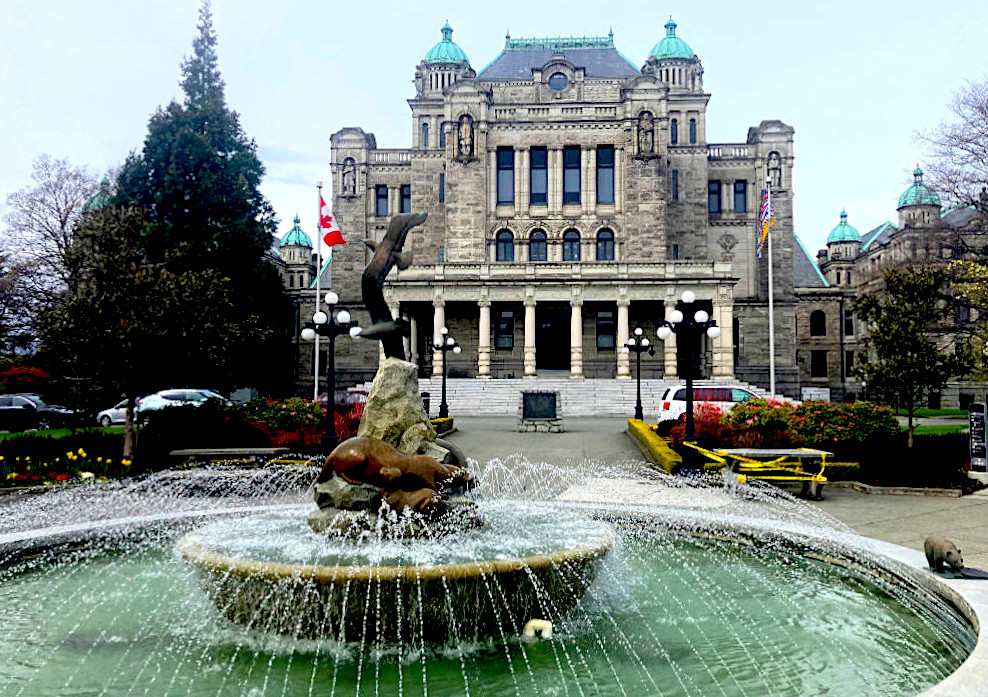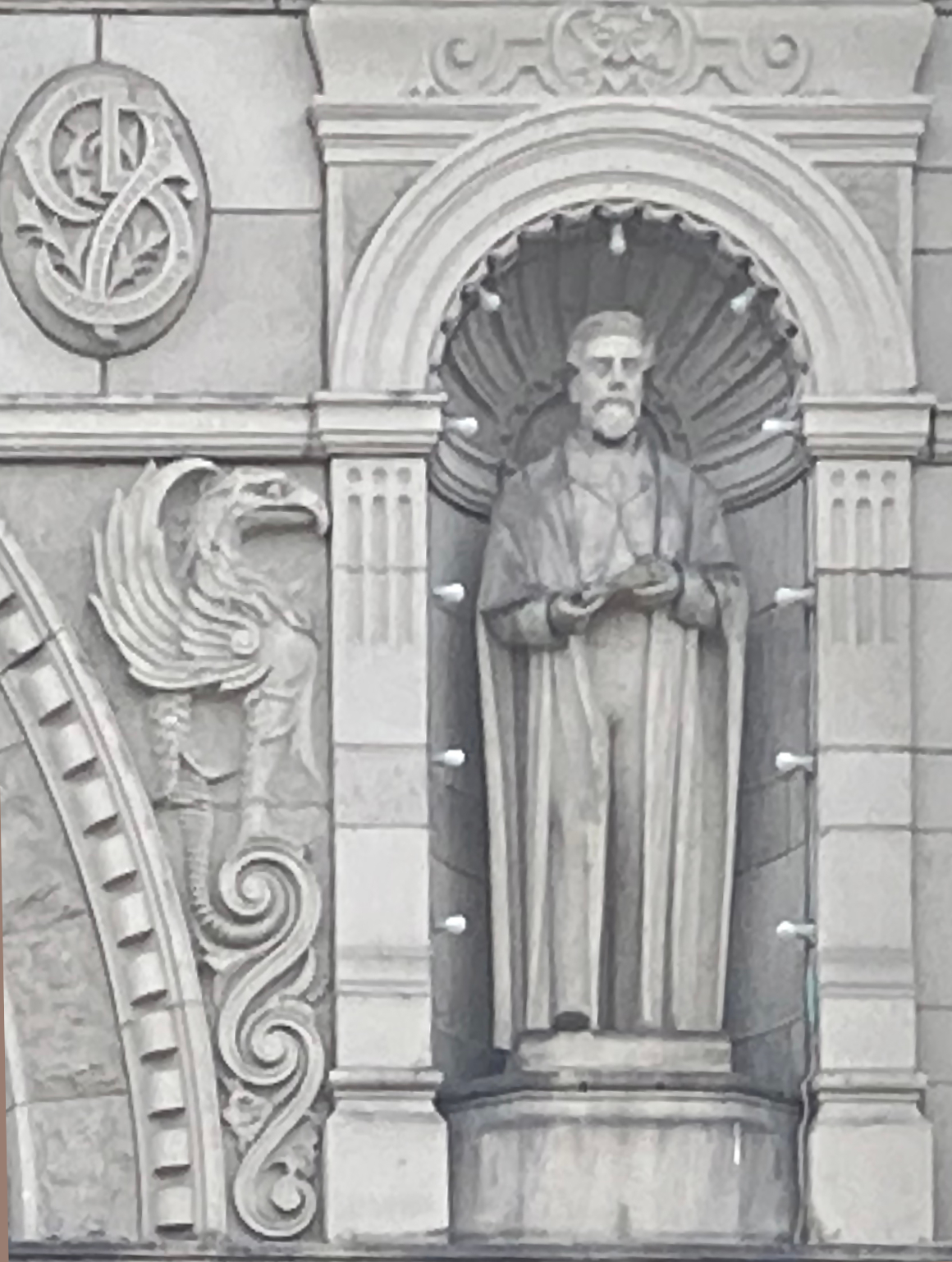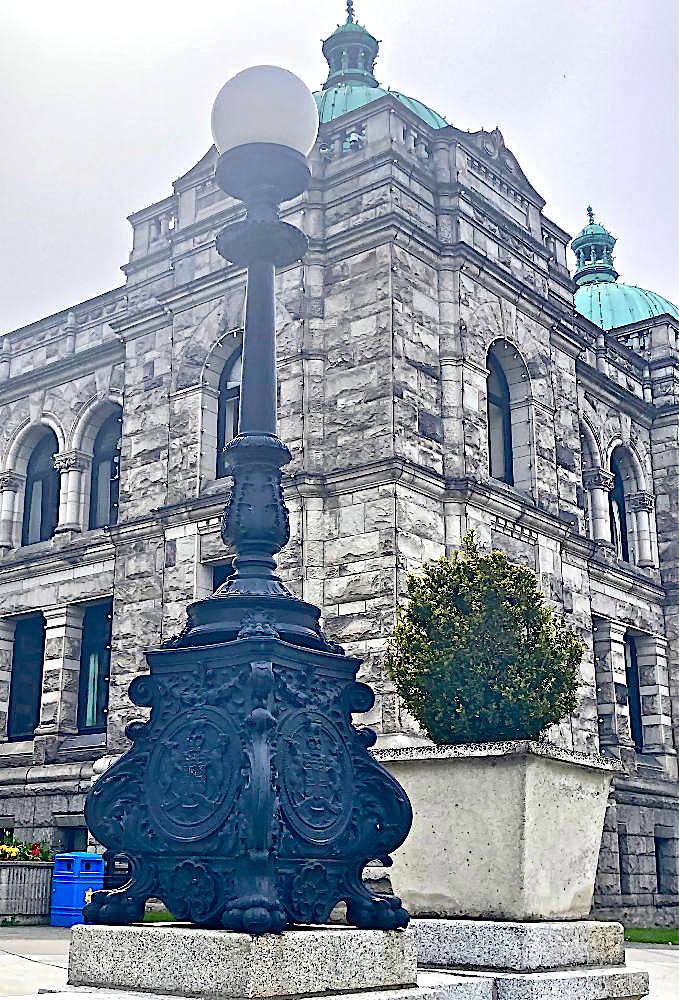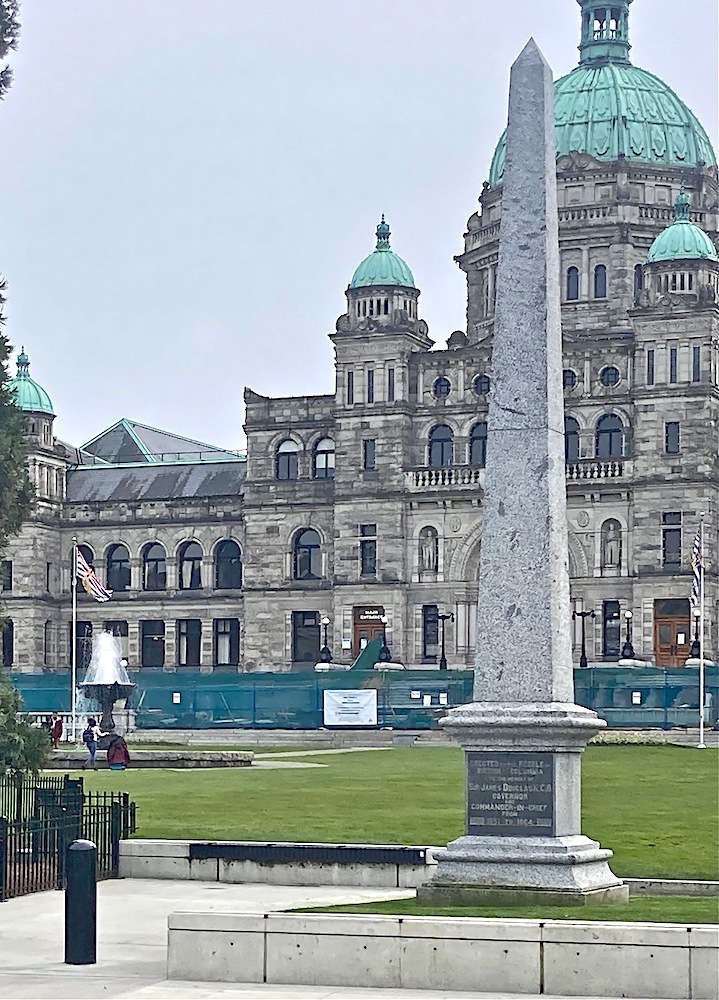Photographs by the author. You may reproduce them without prior permission for any scholarly or educational purpose as long as you (1) credit the photogrpaher and (2) link your document to this URL in a web document or cite the Victorian Web in a print one. Click on the images to enlarge them.]

The B. C. Provincial Legislature (1893-98). According to the Victoria Heritage Foundation, Frank Rattenbury, aged only 25 when he arrived in Canada, and with more ambition than experience, signed himself "A BC Architect" when he presented his design for this grand building. Its confidence and practical dimensions for the available space both inspired confidence, and the plan was accepted. Construction begun in 1893, depending as much on "local labour and materials as possible, to boost Victoria's sagging economy." The same account explains that the "foundation and steps were of Nelson Island granite, the roof of Jarvis Inlet slate, and the exterior of Haddington Island andesite, rendered to a natural rock finish; local Douglas fir timber was used extensively. Marble finished the interior walls, stairways and floors of the Legislature." It opened to much ceremony on 10 February 1898.


Two more views of the Provincial Legislature, from Bellevue Street.
However, there was still much to be done on the interior, and building work went on into the second decade of the twentieth century, with the important addition of new wings and an impressive library completing the complex.
Legislative Library


The Legislative Library, also designed by Rattenbury. Left: Centennial Fountain and South Façade of the Provincial Library. Right: Closer view of the South Façade.
Victoria's population had risen from just 6,000 in 1880 to 20,000 in the late 1890s, and had sufficient employment in various industries such as brewing, shipbuilding, and chandlering for 12,000 workers — fully half of them were employed in the salmon-canneries. Although the new government buildings required for the administration of so booming a province should technically be called "the Legislature," locals continue to refer to them as "The Parliament Buildings." Their construction was a sore point with Mainlanders for some time, since the amalgamation of the two former Crown colonies (New Caledonia and Vancouver's Island), and Victoria's winning out over New Westminster as the provincial capital, meant that all those civil service jobs went to support the economy of the island city — and not that of the Lower Mainland, at a time when the population of Vancouver (19,000 in 1890; 27,000 in 1900) had surpassed that of Victoria, a mere 17,000. Indeed, "even as late as 1914 when the east and west wings were added to the Main Building, many on the Mainland were still pressing for the Legislative Buildings to be transferred brick by brick to the Mainland" (Gregson 74).
Selected Details



Left to right: (a) Main Romanesque Portal and (left) statue of Sir James Douglas. (b) Detail of ornate façade, with the British Columbia's coat of arms. (c) Statue of Sir Matthew Baillie Begbie on right of Main Portal Buildings.
Sir James Douglas, the fur trader and politician who became the first Governor of the Colony of British Columbia. He is often credited as "The Father of British Columbia." Sir Matthew Baillie Begbie was the first Chief Justice of the Crown Colony of British Columbia in colonial times.




From left to right: (a) Cast-iron lamp standard. (b) (b) Albert Bruce-Joy's staue of Queen Victoria. (c) The cast-iron fountain. (d) Buildings and Sir James Douglas Obelisk
The building, complete with its cupolas and domes, is complemented by fourteen statues of historical figures (including such figures as Drake, Captain Cook and Edward Bulwer-Lytton), an impressive fountain, and a larger-than-life bronze statue by Albert Bruce-Joy of the young Queen Victoria. It is all more than a little over-the-top by Canadian standards. When the building was first illuminated for Queen Victoria's Diamond Jubilee, it must have been an amazing public spectacle. Even now it is termed "The most dignified and aesthetically-pleasing structure in Victoria and indeed in all of British Columbia" (Gregson 72).
Fourteen Historical Statues on the Provincial Legislature's Exterior
- Chief Maquinna, chief of the Nuu-chah-nulth people of Nootka Sound, during the heyday of the maritime fur trade in the 1780s and 1790s on the Pacific Northwest Coast.
- Captain George Vancouver, a British Royal Navy officer best known for his 1791–1795 expedition, which explored and charted North America's northwestern Pacific Coast regions
- Sir Matthew Baillie Begbie
- Dr. John McLoughlin, French-Canadian, later American, Chief Factor and Superintendent of the Columbia District of the Hudson's Bay Company at Fort Vancouver from 1824 to 1845.
- Dr. John Sebastian Helmcken, a British Columbia physician who played a prominent role in bringing the province into Canadian Confederation, and the founding president of the British Columbia Medical Association.
- Captain James Cook, British explorer, cartographer and naval officer famous for his three voyages between 1768 and 1779 in the Pacific Ocean and to New Zealand and Australia in particular.
- Sir James Douglas
- Sir Francis Drake, English explorer and privateer best known for his circumnavigation of the world in a single expedition between 1577 and 1580.
- Sir Alexander Mackenzie, Scottish explorer and fur trader known for accomplishing the first crossing of North America in 1793.
- Simon Fraser, explorer and fur trader who charted much of what is now the province of British Columbia.
- Lord Edward Bulwer-Lytton, diplomat and writer, was Britain's Colonial Secretary who oversaw the creation of the colony of New Caledonia in 1858.
- Sir Anthony Musgrave, governor of BC from 1869 to 1871. He died in office as Governor of Queensland in 1888.
- David Thomson, Welsh-Canadian fur-trader, surveyor, and cartographer, known to th indigenous people of Canada as "Koo-Koo-Sint" or "The Stargazer." Over his career, he travelled 90,000 kilometres (56,000 mi) across North America, mapping 4.9 million square kilometres (1.9 million square miles) along the way.
- Colonel Richard Clement Moody of the Royal Engineers, British governor, architect, and soldier, is best known for being the founder and the first Lieutenant-Governor of British Columbia. Port Moody is named after him.
Six Medallions on the Library's Façade

The Shakespeare medallion.
Six circular medallions adorn the Library's exterior: the faces shown are those of the great and influential thinkers and writers of the past. From east to west, they are Homer, Dante, Shakespeare (shown on the left here), Sophocles, Milton, and Socrates. These were selected by E. O. S. Scholefield (1875-1919), who also designed the fourteen historical statues, and carved by Charles Marega (1871-1939) and his assistant, Bernard Carrier (see "The Legislative Library Statuary").
Bibliography
Barrett, Anthony A., and Rhodri Windsor Liscombe. Francis Mawson Rattenbury and British Columbia: Architecture and Challenge in the Imperial Age. Vancouver: University of British Columbia Press, 1983.
Elliot, David R. "Rattenbury, Francis Mawson." Canadian Encyclopedia. Edmonton: Hurtig, 1988. Vol. 3: 1828-1829.
Gregson, Harry. A History of Victoria 1842-1970. North Vancouver: J. J. Douglas, 1977.
"The Legislative Library Statuary." Legislative Assembly of British Columbia. Web. 20 April 2023.
Victoria Heritage Foundation. "B.C. Legislative Buildings." Web. 20 April 2023.
Created 21 April 2023